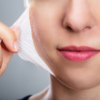- Empty cart.
- Continue Shopping
Does Oily Skin require applying oils on face for Nourishment?

Everyone needs a certain amount of natural oil to keep their skin supple and moisturized. Skin type is determined by how much oil the skin on your face produces; depending on this, your skin type can be categorized as dry, combination or oily.
How to Know if You Have Oily-Type Skin
If your skin exhibits the following, then you have an oily skin type:
Your face is shiny and usually appears greasy later on in the day. Makeup doesn’t stay on and seems to “slide” off. The oilier areas of your face have blackheads, pimples or other types of acne. Pores are visibly enlarged, especially on your nose, chin and forehead.
Take special note of your T-Zone. The T-Zone is the region of the face consisting of the forehead and nose which naturally tend to have more active oil glands that may produce excess sebum. If your T-Zone is oily but the rest of your face looks normal or dry, then you have combination-type skin.
Scientific Reason of having Oily Skin
Sebaceous glands are located within the skin and are responsible for secreting an oily substance called sebum. Sebum lubricates the skin, protecting it from drying out or becoming irritated. This oil, along with sweat, is secreted through the pores. When this process goes smoothly, sebum not only lubricates your skin, but it also removes dead skin cells and other irritants from your pores. However, when over-active sebaceous glands produce excess sebum, your skin looks shiny and your pores can become clogged, leading to a host of skin imperfections.
Normally, people with oily skin use strong or harsh face washes to clean their face multiple times a day and don’t use any oil or moisturizer after that. There is a popular misconception that oily skin have oils, and hence there’s apparently no need to put oils on your face as it may clog the pores .
Forget all those misconceptions. Your oily skin also needs proper hydration and nourishment.
If it isn’t hydrated properly, this could encourage the skin to produce even more sebum to compensate, making the vicious circle of oily skin even worse.
That means if you use harsh and strong products to clean your face, then after a certain period of time, your skin will be oilier, more sensitive and acne prone.
What to do then?
So, it is always better to use natural, harsh-chemicals free skincare products that will be gentle on your skin and fulfill your needs. Use any naturally derived cleanser balm instead of any harsh facewash with strong surfactants, and then apply the correct face oil or moisturizer after that.
Botanical oils offer a beautifully natural way to get your skin back to good health, even if it’s oily! They can be used pure, diluted, or as an active ingredient, depending on your skin concerns.
Can People with oily skin use any oil for face massage?

Before choosing right botanical oil for oily skin, you must take into account the oil’s comedogenic rating (from 0 to 5) and skin-sensitization rating. Each oil has specific characteristics that determine whether it’s comedogenic or allergenic, so it’s crucial to find out this information before using it. For example, jojoba oil has a comedogenic rating of 0 and can be used by all skin types, while wheat germ oil has a rating of 5, making it highly comedogenic. The oils with a low comedogenic rating (0 – 2) are beneficial for oily skin. These oils are excellent massage oil for even the entire body or scalp.
0 – NON-COMEDOGENIC (do not clog pores)
1 – SLIGHTLY COMEDOGENIC (very low chance of clogging pores)
2 – MODERATELY LOW COMEDOGENIC (may clog pores for some but be fine for most)
3 – MODERATELY COMEDOGENIC (will clog acne-prone/oily-skin type)
4 – FAIRLY HIGH COMEDOGENIC (will clog pores for almost all skin types)
5 – HIGHLY COMEDOGENIC (will clog pores)
Here is the list of some popular oils with their comedogenic rating:-

Almond Oil – 2
Apricot Kernel Oil – 2
Avocado Oil – 2
Argan Oil – 0
Castor Oil – 1
Coconut Oil – 4
Grape Seed Oil – 2
Hazelnut Oil – 2
Hemp Seed Oil – 0
Jojoba Oil – 0
Olive Oil – 2
Safflower Oil (Carthamus Tinctorius) – 0
Sandalwood Seed Oil – 2
Sesame Oil – 2
Soybean Oil – 3
Sunflower Oil – 0
Wheat Germ Oil – 5
How to Use Face Oil for Oily Skin
The best advice for using face oils for oily skin is to think about when and how often you use them. Oily skin won’t benefit from applying oil twice a day, so only use it once. It’s also best used at night, as the skin naturally produces less sebum when we’re asleep.
So by all means use face oil for oily skin as part of a healthy skincare regime, just make sure it’s the right one for your oily skin!






